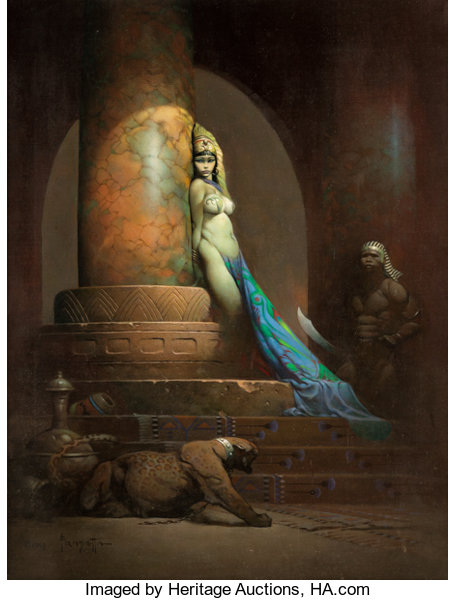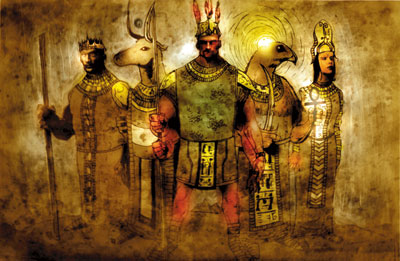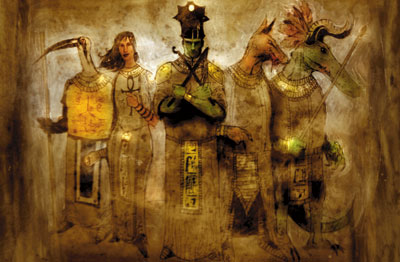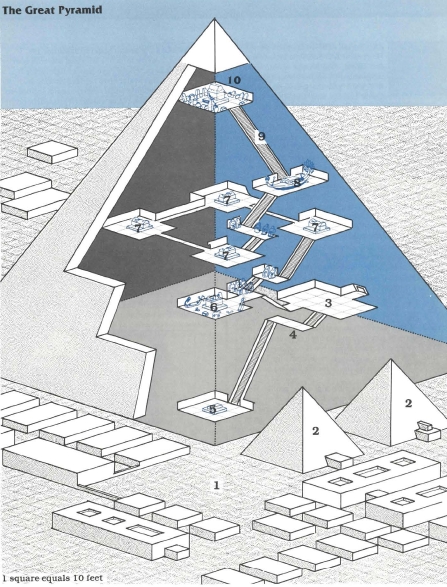Egyptian Mythos

Egyptian Mythos

| Ra | Anhur | Anubis | Apep | Apshai |
| Bast | Bes | Flame Snake | Geb | Horus |
| Isis | Nephthys | Osiris | Phoenix | Ptah |
| Seker | Set | Minions of Set | Shu | Tefnut |
| Thoth | - | True Ankh | - | Hieroglyphs |
| - | - | - | - | DDG |
Nut

| All alignments | Anubis |
| LG | Osiris, Shu, Tefnut |
| NG | Ra, Isis, Shu |
| CG | Anhur, Bast, Nephthys, Shu |
| LN | Geb, Horus, Ptah |
| N | Geb |
| CN | Bast |
| LE | Set |
| NE | Geb, Set |
| CE | Bast, Set |
| Farmers | Apshai, Osiris |
| Anyone seeking vengeance | Horus |
| Beings dealing |
Isis |
| Beings wishing for luck | Bes |
| Seekers of knowledge | Thoth |
| Worshipers of light | Seker |
The ancient Egyptians developed a culture lasting over 3,000 years.
It only
natural that their faith would undergo a change
that time.
Their deities aged, with Ra starting as the ruler
and growing senile and Osiris taking over after
being killed by Set and being brought back to life.
The pantheon represented is one with Ra in prominence
only because there are more beings of power in
early grouping.
Temples were many in Egyptian society,
but each city had only one major deity.
All the other deities could be worshiped,
but only in an inferior position.
They are shaped in a large rectangle,
and enclosed with high walls.
The entrance (the only obvious one, though there are several secret
ones)
is supported by 2 large pylons that are marked with the symbol
of the of the
city.
There is always a large public hall whose walls are covered with hieroglyphics
depicting the story of the deity of the temple,
but no image of that being is permitted here.
There is always an inner sanctuary
where the deity's image is presented in the best materials the sect can
afford
(marble, alabaster, silver,
gold,
and the like).
Near the temple is a cultivated garden where the priests and priestesses
of the temple have to bathe every day.
This area is holy,
and if desecrated, <cf. ceremony: consecrate
ground>
the entire temple is rendered useless.
Offerings are always objects that are pleasing to the eye and made
to dress up the altar,
either in the outer hall || the inner court.
Only priests && priestesses are allowed to enter the inner
sanctuary.
Clerics of less than fourth level are
expected to serve their deity by serving the people with their knowledge,
healing,
or the like.
Clerics of the fourth through sixth level serve the needs of the temple,
either by being messengers,
using their powers to fight for the sect,
or whatever else the higher clerics need.
Female clerics can rise no higher than 9th level in ability,
but it is necessary for all 11th level males or higher to take on a
female cleric as a consort and advisor,
and these women often
in the stead of their male counterparts
the males have to be away from the temple.
The female clerics keep all official temple records.
All clerics wear white in some part of
their dress,
and it is a
sin to be stipped of white for any reason
and is cause for going on a major quest
for redemption if it happens.
Otherwise,
clerics are as other humans,
save that the males shave their heads upon attaining the fourth or
higher levels,
while the females wear long hair at all times.
Egyptian clerics can only rise in levels by donating large sums to
the sect for its use
(in AD&D terms it is necessary to
donate the equivalent of the needed XP in gold
in order to rise in levels).


<Rope Use, Tie (reef knot: uses), Knot>
<the Whelan piece was chosen as it relates the the 24 Solars thread
at DF>

prometheus713 wrote:
Gary, let me preface my
question by saying that I am awed in the presence of the master. Having
gotten that out of the way I wanted to ask you a non-rules AD&D question.
was your inspiration for Tomb of Horrors and how long was the creation
process? I always saw Tomb of Horrors as somehow linked to your Necropolis
super module, at least in my own mind.
Wishing you lasting good
health,
Archie

Howdy,
A chap named Alan Lucien have me the inspiration...as I believe I stated in my original ms. for the module.
The Necropolis super-module
was inspired by my own initial dungeon encounter area with an Egyptian
theme.
As I was studying/researching
the Ancient Egyptian religion and the Duat underworld, the whole was pretty
easy to create at the time.
Cheers,
Gary
For those interested in tryly "Old Religion":
http://news.nationalgeographic.com/news ... urial.html
Be sure as well to read the link about snake magic.
![]()
Gary

Elfdart wrote:
Colonel, lately I've been
re-reading books of folklore and mythology from all over the world. One
book about Middle Eastern mythology makes it pretty clear that the ghoul
was based on hyenas: desert-dwelling, laughing, corpse-eaters. I noticed
that you created Yeenoghu as demon lord of ghouls and gnolls. Did you make
the ghoul/hyena connection way back then?

As far as I recall I had
discovered that the ghoul was from Egyptian
folklore, a demonic creature.
I then connected them to
hyenas,
famed scavengers, via Yeenoghu.
As I have seen plenty of
hyenas as a lad at the zoo, heard their calls and smelled their stink,
that seemed most fitting to me.
I really dislike those animals ![]()
Cheerio,
Gary
Quote:
Have a question for you
concerning ancient Egypt (from another thread that tweaked my interest):
How was the court of the Pharoah arranged? I assume that it could be considered
a theocracy... but what were the titles held by subordinates and did they
have actual control over fiefdoms around the Nile valley or further? Or
was the Pharoah strictly top dog?
I ask this of you because
I assumed that much study went into the writing of Necropolis, and I thought
you may have run across information pertaining to this.

Pharoah was absolute ruler,
a living god.
The various districts of
Egypt were ruled by governors, but they were generally absloutely under
the thumb of the king.
The military was absolutely
loyal too.
I do not have an organizational
chart of the governemnt under the pharoah--the palace officials, priests,
governors, overseers, and scribes. In all my reading I never came across
anything resembling a treatment of this. Sorry.
Thank you dear sir!
Duglas K[/B][/QUOTE]
Quote:
Originally posted by
Lord Zardoz
This is related to politics,
but thankfully, not to firearms.
What non US country do you admire most, and why?

As one of the very select
number who are members of the Zardoz Film Fans, how can I not respond?
Actually, from my historical
interest perspective, I admire many other countries for one or more reasons.
Which one I admire most
is a very difficult question for me to answer.
The criteria are manifold,
so without some specific bases for selecting one, I can't name a special
one.
I
mention that Ancient Egypt holds a special place in my heart, for it lasted
so many centuries, and the people of the land wanted the afterlife to be
no more than a continuation of their fleshly existance there. That's quite
a nod for living under pharoah's rule.
Cheers,
Gary

Quote:
Originally posted by
ColonelHardisson
Gary, given your apparent
interest in Egyptology (based on your epic adventure "Necropolis"), I was
wondering if you'd gotten a chance to see the recent "Mummy" movies - "The
Mummy" and "The Mummy Returns"? I love these films, for their breezy nature
and old-fashioned derring-do - plus, there is something very reminiscent
of a good D&D session about them.

Howdy Colonel ![]()
I've loved Egyptology since
I was about five years old and my father took me to see the large exhibit
in the Field Museum in Chigaco.
Next to the Lincoln Park
Zoo, that was my favorite Sunday outing.
I have not really pursued
Egyptology other than as a dilitant, but I have a fairly large collection
of reference books on Ancient Egypt.
most of Budge's old works
amongst them, as well as some issues of KMT magazine...
Indeed, I did see the "Mummy"
movies, includng the original Boris Karloff ones ![]() thus I have both many tanna leaves handy as well as a cat.
thus I have both many tanna leaves handy as well as a cat.
those flesh-eating (as opposed
to dung-eating)scarab beetles in the new flicks are absolutely horrible.
A swarm of those could take
out most D&D parties in a trice, I fear.
Speaking of films that recall D&D sessions, "The Deep," is in my estimation a great one for a modern equivalent of same.
Cheers,
Gary

Quote:
Originally Posted by Sir
Elton
Gary,
I wondering about the nation of Khemet for Necropolis, or a D&D game on Egypt in general. All three kingdoms seems like a good setting for Adventure, but which Kingdom: New, Middle, or Old, would you prefer adventuring in?

Hi SirElton,
Sorry to have missed this post until now.
Using Khemit from Necropolis
and the Epic of Aerth world setting is likely a lot less work for
the DM that building something from the historical Old, Middle, or New
Kingdom models.
For a Conan-like milieu
with appropriate rules I'd go for the Old Kingdom, while a Classical Antiquity
one would fit best with the New Kingdom.
That sort of leaves the
Middle Kingdom out,but...
Cheers,
Gary

Aside from the usual weekly
campaign game of LA that I run--and we are going to alternate those sessions
with C&C game ones for a time at least--the usual games played here
are:
Settlers of Catan,
Rail
Baron, backgammon, senat, and cribbage.
<bold added>
Quote:
Originally Posted by gizmo33
That makes sense for 3E,
because 3E seems to put the positive/negative material planes on the good/evil
axis. But ADnD as I recall didn't really define it so clearly - ex. creatures
like the Xeg-Ya/Xag-Yi seem like mirror images and neither good nor evil.
The one, as I recall, doesn't heal anyone. The later books, like Manual
of the Planes, made Positive a kind of healing energy, but that was after
Gary's involvement (I think). I always had this feeling in ADnD that the
positive material plane was equally dangerous, and it was conceivable that
such energy could power undead. Perhaps it's just a case of my imagination
running off due to a typo? I was just wondering if there was a design,
perhaps abandoned later on, that explained what postive material energy
was in ADnD.

Actually, the negative isn't
necessarily evil or inherantly malign.
Consider Osiris,
the Egyptian god of the dead and
afterlife world, the Duat or Tuat.
Neither is positive necessarily
good ot benign.
Using the same pantheon,
consider Ra supporting Set over
Horus
son of Osiris and
Isis.
Osiris
put him in his place, though... <paranoid>
Cheers,
Gary
Quote:
Originally Posted by John
Drake
Well it certainly worked!
So, Gary, as this topic of deities and such continues, I'm curious as to
which mythology or pantheon you have a soft spot for, out of real-world
mythologies? My personal fav has always been the Norse, followed by Celtic
and Egyptian.

Well...
I likely have spent more time with Egyptian than any other, and I find the material regarding the Duat fascinating, compelling; but otherwise I enjoy virtually all the well-detailed mythologies equally.
Cheers,
Gary

Quote:
Originally Posted by Fifth
Element
What is your favourite real-world
mythology? I mean in the sense of Greek, Norse, etc.
As a follow-up, what mythology lends itself best as inspiration for D&D?

Egyptian mythology for its
plethora of deities and its underworld.
Next comes Hindic for its
array of strange deities and the many stories.
I designed D&D with little regard for mythology; more for folklore, legend, and authored fiction.
Cheers,
Gary

Quote:
Originally Posted by jasin
Could you provide more details
on this, please?
I had some ideas for a game that involved a world with a single solar as the spirit/ruler/personification of the Sun and a single planetar as the spirit/ruler/personification of Earth. The epic overarching plot would involve the planetar rising up against the solar: a bit of gnosticism, a bit of Ra vs. Apophis...
What got me thinking along these lines were mostly just the names for the creatures, "planetar" and "solar" which I never thought were chosen for any particular reason, but now that you mention being inspired by Theosophy, it seems I might have been going back to the roots without being aware of them.

I do not pretend to be an
expert on Theosophy, so you must do your own research in regards information
there.
You have the correct hierarchy for the Solar and Planatar, so I can not add anything there.
As for Egyptian deities at
odds, the big dustup was between Ra and Osiris when Ra was taking Set's
sind in regards who should rule earth, Horus son of Osiris or Set.
Osiris onfrmed Ra that he
had "many savage faced messengers" to assert his claim, and Ra backed down.
Cheerio,
Gary
Quote:
Originally Posted by mhacdebhandia
Jasin was actually referring
to the backstory of the television series Stargate SG-1, but I for one
will forgive you for not recognising it.

Now i know why i have never
been fond of that program...the writers don't know their Egyptian mythology
Gary

Well, haakon1,
It seems as if the writers for that program not only do not know much about Egyptian mythology, but are also equally misinformed about the Norse, for Thor was of the Aesir race...
anyway, this reinforces why I shun the show, much as U do the new BBC production of Robin Hood. What a travesty!
Cheers,
Gary
Groaning Spirit: Ra = Brahman (not to be confused with Brahma), Osiris
= Shiva (except he gets pwned by Seth), Isis = Parvati, Horus = Muruga/Kartikeya,
however you want it
